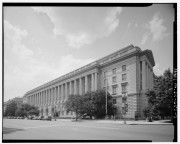Last week, the Chronicle of Philanthropy reported on a U.S. District Court hearing in San Francisco regarding access to IRS Form 990’s public data. Although reading the minutiae of the case has a soporific effect, the expected ruling’s sunlight is sure to awaken more than just GuideStar’s webmaster.
The case – Public.Resource.Org v. United States Internal Revenue Service – has been going on for nearly two years but, according to the Chronicle, U.S. District judge William Orrick has planned to rule in favor of the plaintiff. Founder of Public.Resource.Org Carl Malamud authored an April 2013 letter to the IRS and other executive branch officials explaining his position. According to the Freedom of Information Act, agencies “shall provide the record in any form or format requested by the person if the record is readily reproducible by the agency in that form or format.” The issue up for debate is that Malamud has requested Form 990 data in a modernized electronic file (or other machine-readable format) but has only received the raw data in image format. Having dealt with data readability issues myself, there is a big difference between images and machine-readable format – only in the latter can you easily create a searchable database (and converting the former to the latter requires a great deal of time, memory, and resources).
According to court documents, Public.Resource.Org’s main argument is that the requested form is “readily reproducible in machine-readable format.” Opposing this view, the IRS is arguing: a) “the requested records are not readily reproducible in MeF Format” and b) the IRS “was not required to maintain the records in releasable MeF Format.”
Although this issue appears to be in the weeds and only specific to Malamud and his organization, a ruling in favor of Public.Resource would greatly affect many who participate in and study the nonprofit sector. In September 2013, for example, the Aspen Institute’s Philanthropy & Social Innovation released the second edition of their report “Information for Impact: Liberating Nonprofit Sector Data,” which focused exclusively on the importance of this very issue. Their argument in favor of opening electronic data, i.e., making it “truly open,” is threefold: open data would 1) make it easier for authorities to detect fraud, 2) “spur innovation in the nonprofit sector,” and 3) help make more sense of 990 data.
And Public.Resource.Org’s support doesn’t stop there. Public transparency groups have also lauded Malamud’s efforts, from the Sunlight Foundation to the Electronic Frontier Foundation.
Yet, machine-readable 990 data is not entirely missing from philanthropic analysis; organizations like Charity Navigator, GuideStar, and the Foundation Center spend millions of dollars each year converting the data from the IRS into a usable format. The data provided by these organizations is incredibly useful for research, nonprofit projects, and businesses. In fact, it is so useful that even the IRS buys back a half-million dollars' worth of data from GuideStar each year!
Beyond the mere utility of the electronic data, it seems that this sort of transparency in an increasingly digital age is significant to the operation of a democratic republic. According to the secretary-general of the Organisation for Economic Co-operation and Development, “Openness and transparency are key ingredients to build accountability and trust, which are necessary for the functioning of democracies and market economies.” Even according to a Federal Register memo by President Obama, “Transparency promotes accountability and provides information for citizens about what their Government is doing.”
Interestingly enough, the memo continues:
My Administration will take appropriate action, consistent with law and policy, to disclose information rapidly in forms that the public can readily find and use. Executive departments and agencies should harness new technologies to put information about their operations and decisions online and readily available to the public.
Nevertheless, the Internal Revenue Service – a bureau of the executive department of the treasury – still went to court to fight against Malamud’s request rather than comply with the administration’s promise.
All else staying the same (i.e., the current structure of philanthropy and the status quo relationship between nonprofits and government), streamlining the process to open 990 data is a step in the right direction. And so far, so good: according to Thomas Burke, Public.Resource.Org’s lawyer, the case “looks like a win for Public.Resource and for the people who care about electronic access to public documents.”






